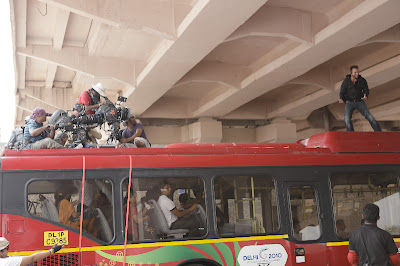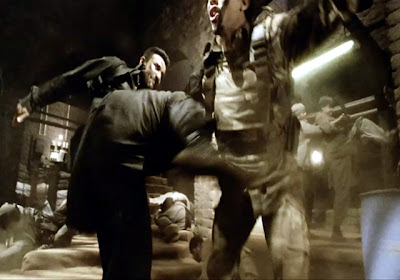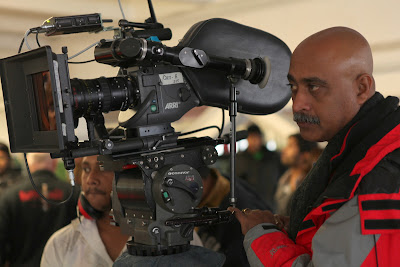[dropcap]I[/dropcap]ndia got her very own Bond in the form of ‘Agent Vinod’, a swashbuckling, globetrotting, tuxedo-wearing secret agent. This film also brought the charismatic director-cinematographer duo of Sriram Raghavan and C.K. Muraleedharan together for the third time, the first two being ‘Ek Hasina Thi’ and ‘Johnny Gaddar’. Needless to say, Agent Vinod packs a lot of punch and is high on action, suspense and drama. This much awaited film took 140 days to shoot, and was filmed across countries like Switzerland, Russia, Latvia and U.K.
Bollywood is no stranger to action flicks. Cinematographer C.K. Muraleedharan feels that the look of the film is what sets it apart from other action movies. Work began on the film three years ago and shooting it turned out to be every bit as challenging as it appears. “Agent Vinod is a very complex film,” he says. “The narrative keeps you at the edge of your seat, which means you have to shoot the film accordingly. You cannot have formatted frames, slow movements, etc. I wanted a very real and rugged look so most of the film is shot inconsistently, without keeping a steady frame. It’s like everything is changing, whether in an action sequence or a dialogue. I wanted to bring in a kind of consistency in inconsistency. You need a lot of intuition to shoot like this. I relied heavily on the zoom lens, and would change the frame according to my instincts. Every take turned out to be different from the other. What you see in one frame, you won’t see in the next.”
Muraleedharan had a special monopod designed for the purpose. “I needed a monopod so that I don’t stay steady in any shot and can keep moving according to the action. We researched a lot and bought a strong monopod. We had a head manufactured for it so that we could fit the Arri 435 properly. We also added a fiber, cylindrical-tilting mechanism to it, so that we could lock it with one lever. At a pull of a key, it could go up or down. I kept telling my attendant to hold on to it, just for safety in case it slips. I could then take the camera with me to any height.”

It’s tough to shoot a film that keeps jumping across countries and seasons. Ask Muraleedharan what it meant to globe-trot along with Agent Vinod and he gushes, “At one point, we had to coordinate four different languages for action on set! Each country has a distinctive feel to it and you have to capture the vibe of the place, so I had to use a particular coloring, framing and shooting style for each place. I also wanted to create a lasting image for each country, so the next time someone talks about, say Afghanistan, I want them to immediately think of the image that they saw in Agent Vinod. We also had to pass off some places in India itself. For example, it was impossible to shoot in Somalia, so we shot here. It required a lot of planning, but I’m sure you won’t be able to tell which portions we’ve cheated. I’m not going to tell you either,” he laughs.
Muraleedharan rose to the challenges like an artist should. “I work on a subconscious level and feel that colours should look real as well as stir some feelings in the audience. I believe that I’m more of a storyteller, than a technician. The director has told me a story with his words, and I have to present it on screen through my interpretation, keeping his thoughts in mind, but simultaneously going one step further. I don’t want my work to stand out- it needs to gel with the film. Only then I have succeeded.”

Referencing for the look and feel of the film included ‘tons of things’ from how the character should behave to how Bond would have handled the same situation. “We wanted our hero to be a Hindi film hero,” explains Muraleedharan. “We kept reminding ourselves that he’s not James Bond, he’s Agent Vinod, whether through the actor’s posture or the framing. Like when panning from Kareena’s close up to Saif, who is standing a bit far away, we have to shoot it in a way to imply that Kareena hasn’t realized that the door’s opened. It may not be real, but we have to make sure it work’s that way, as it’s a Hindi film moment. These are things we borrowed from our filmmaking culture to come up with a different film altogether.”
Improvisation was key. “Sriram sent me a painter’s work as a reference for a particular scene, a mise-en-scene, which is more than a three minute-long shot. We rehearsed it for three days before shooting it on steadicam. Approximately fifty cues had to be given during the shot. Things are blowing up, things are falling from the roof, a shadow play’s happening in the middle of it all, people dying in the frame- all in a day’s work. It was impossible to light up as it was being shot on location, so I devised lighting I could use. I’ve shot tons of documentaries, so I kept borrowing whatever techniques from there that I could use in this film. Even the way you behave on the set matters in these cases,” he says.

Muraleedharan credits the challenges posed by the film for it’s unique look and feel. “If I have everything I want, then I’ll end up shooting it the way I have planned it. However, if I don’t get what I want, then I have to come up with a plan B, which is not limited to my outdated thinking,” he says. “Even Sriram believes in this. It’s a kind of a tuning we share to come up with things on the set. Many times Sriram doesn’t have any clue of what I’ve framed and shot. I have my monopod and zoom lens, I’ll frame something and shoot a few takes, and he’ll tell me this is what I need, so we communicate very well. We’ve shot scenes we haven’t even discussed how to shoot before; we’ve just found a way. Sure, we might’ve cribbed about it at the end of the day- I wish we would’ve had this, etc- but at the same time, we’re not unhappy about what we’ve achieved. That’s something both Sriram and I enjoy. We don’t follow any rules as such, and I’m very happy for that.”

Taking improvisation a step forward, Muraleedharan talks about the time he reached the set for the first time, on the day of the shoot, only to find out that there was no place for him to light. “I was busy with other shoots, so I hadn’t had the time to check the set beforehand, and I realized I couldn’t light in the space I had. So I made small 1×2, 3×4 size mirrors, stuck it on top and around the set, and lit up through the mirrors. I used 5ks, Solars and Baby. I started bouncing light off mirrors as I couldn’t put up cutters because it would make the set claustrophobic. I also wanted contrast as it was meant to be somewhere underground in Afghanistan, and it was impossible to cut off any unwanted light in the set I was in, so I used only the patch of light I wanted and used the spill. I lit the whole set that way, it gave me a lot of play of shadow and light, and it created an atmosphere of mystery that was needed for the story.”
Muraleedharan also speaks of how, at the end of the day, all the framing came down to pure instinct. “We didn’t have any set framing references. We did have some storyboards for the action sequences, but on the whole, the framing was story driven. We’d decide how to shoot a scene on the spot. Sriram and I have an understanding as to how a scene should be lit and how it should be shot. It’s trust that matters rather than having a concrete plan. We didn’t plan the colour schemes, nothing. When you see the film, it will be difficult for you to figure out whether it’s Bond, or a 70’s Bollywood inspired flick. It just evolved.”

Everything that went on the final print was created with a purpose. “Someone saw the film and commented that it’s dark,” says Muraleedharan. “I can match the day skin tones of the actor with the dark ones and it will be the same, I told him. It’s not the contrast or exposure, it’s the feeling of darkness that you get from the scene. Darkness has to be created. As long as your light is correct, you can create darkness. I can’t tell you if the contrast is 1:2 or not. I have a visual in my mind and I create it. I go by how it looks, and not by mathematics.”
 Muraleedharan has boiled the art of cinematography down to pure instinct, understanding and experience. “I never carry a meter- my chief assistant does. I rarely check the reading. I trust him completely on that front. I look through the viewfinder, I know what should work, and tell him to adjust the light accordingly. It takes more time to unlearn, than to learn. All these years, I was trying to unlearn. One is stuck with a lot of things that you learn from school, in terms of light continuity, matching, ratios, etc. It took me a long time to throw away all that and realize that an image doesn’t follow theory, it follows what you want to finally create onscreen. You definitely need to use the tools, but what you create is as per what you want. The tools only help you create it. I’m not averse to any technology. I don’t cling on to my passion for film, etc. I’ll use whatever I need to get what I want. I used the zoom lens continuously through this film, even for re-framing within the shot. While I was learning, we hated the zoom and didn’t find it aesthetically appealing at all. It all comes down to how you use the technology. There should be freshness in what you’re seeing, so that you can reinvent every time. If you’re bored with your work, even the audience will get bored.”
Muraleedharan has boiled the art of cinematography down to pure instinct, understanding and experience. “I never carry a meter- my chief assistant does. I rarely check the reading. I trust him completely on that front. I look through the viewfinder, I know what should work, and tell him to adjust the light accordingly. It takes more time to unlearn, than to learn. All these years, I was trying to unlearn. One is stuck with a lot of things that you learn from school, in terms of light continuity, matching, ratios, etc. It took me a long time to throw away all that and realize that an image doesn’t follow theory, it follows what you want to finally create onscreen. You definitely need to use the tools, but what you create is as per what you want. The tools only help you create it. I’m not averse to any technology. I don’t cling on to my passion for film, etc. I’ll use whatever I need to get what I want. I used the zoom lens continuously through this film, even for re-framing within the shot. While I was learning, we hated the zoom and didn’t find it aesthetically appealing at all. It all comes down to how you use the technology. There should be freshness in what you’re seeing, so that you can reinvent every time. If you’re bored with your work, even the audience will get bored.”
Speaking of his team, he says. “My immediate team is my chief assistant, Ramani Ranjan Das, who has been with me for ten years now. We understand each other very well and he helps me greatly. We discuss a lot about lighting schemes and how they should be executed. My focus puller, Satish Reddy, has been with me for a long time and is very experienced. I interact with my team a lot, and they keep coming up with lots of suggestions. It helps me review things. Vinod Kumar helps me with stock. My 4th assistant was in charge of shooting on the 5D. My gaffer, Kamleshwar Mulchand, and I go a long way back. Dharam Bhurji, my grip, is a very enthusiastic man and is always there with what you want. They are my support system,” says Muraleedharan. The final onscreen drama is a result of a lot of hard work, preparation and co-ordination of various departments. “The key thing that contributes to the film is that we all enjoyed shooting it. We loved what we were doing, and that’s what made it work.”
As with all action thrillers, VFX was an extremely important part of the film. Keith Devlin from Prime Focus was the VFX supervisor.
Lenses: Ultra primes were used as they’re lighter than the Master primes, and there were a lot of monopod and handheld shots. The zoom lens was HR and Optima (15-45mm).
Camera: Arri 235, 435 and Canon 5D. Usually a 2-camera setup, a 435 and 235, were used. Some action sequences were shot with 4 film cameras and 3 5Ds. Muraleedharan zeroed in on the 5D after conducting various tests for quality. The lightweight and compact size of the camera was also a bonus. “We made some mechanisms for the 5D as well,” he says. “We’ve used it extensively through the film and even crashed a couple of them during the action sequence.”
Stock: Kodak 50D, 200T and 500T. The 50D was used when shooting outdoors in deserts. 3 Perf.






 Muraleedharan has boiled the art of cinematography down to pure instinct, understanding and experience. “I never carry a meter- my chief assistant does. I rarely check the reading. I trust him completely on that front. I look through the viewfinder, I know what should work, and tell him to adjust the light accordingly. It takes more time to unlearn, than to learn. All these years, I was trying to unlearn. One is stuck with a lot of things that you learn from school, in terms of light continuity, matching, ratios, etc. It took me a long time to throw away all that and realize that an image doesn’t follow theory, it follows what you want to finally create onscreen. You definitely need to use the tools, but what you create is as per what you want. The tools only help you create it. I’m not averse to any technology. I don’t cling on to my passion for film, etc. I’ll use whatever I need to get what I want. I used the zoom lens continuously through this film, even for re-framing within the shot. While I was learning, we hated the zoom and didn’t find it aesthetically appealing at all. It all comes down to how you use the technology. There should be freshness in what you’re seeing, so that you can reinvent every time. If you’re bored with your work, even the audience will get bored.”
Muraleedharan has boiled the art of cinematography down to pure instinct, understanding and experience. “I never carry a meter- my chief assistant does. I rarely check the reading. I trust him completely on that front. I look through the viewfinder, I know what should work, and tell him to adjust the light accordingly. It takes more time to unlearn, than to learn. All these years, I was trying to unlearn. One is stuck with a lot of things that you learn from school, in terms of light continuity, matching, ratios, etc. It took me a long time to throw away all that and realize that an image doesn’t follow theory, it follows what you want to finally create onscreen. You definitely need to use the tools, but what you create is as per what you want. The tools only help you create it. I’m not averse to any technology. I don’t cling on to my passion for film, etc. I’ll use whatever I need to get what I want. I used the zoom lens continuously through this film, even for re-framing within the shot. While I was learning, we hated the zoom and didn’t find it aesthetically appealing at all. It all comes down to how you use the technology. There should be freshness in what you’re seeing, so that you can reinvent every time. If you’re bored with your work, even the audience will get bored.”

